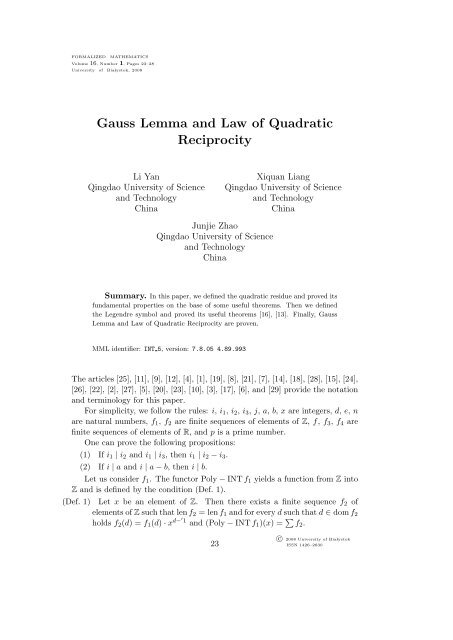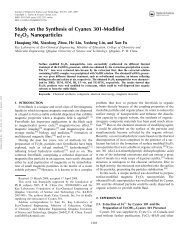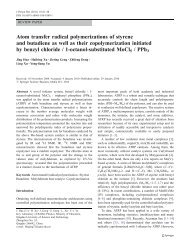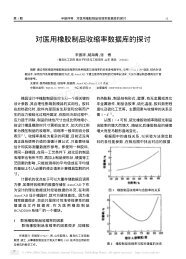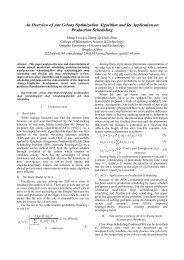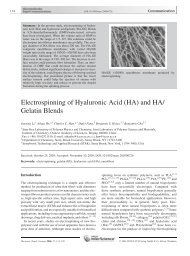Gauss Lemma and Law of Quadratic Reciprocity
Gauss Lemma and Law of Quadratic Reciprocity
Gauss Lemma and Law of Quadratic Reciprocity
Create successful ePaper yourself
Turn your PDF publications into a flip-book with our unique Google optimized e-Paper software.
gauss lemma <strong>and</strong> law <strong>of</strong> quadratic reciprocity 25(15) Suppose p > 2 <strong>and</strong> a gcd p = 1 <strong>and</strong> a is quadratic residue mod p. Thenthere exist integers x, y such that (x 2 −a)modp = 0 <strong>and</strong> (y 2 −a)modp = 0<strong>and</strong> x ≢ y(mod p).Let f 1 be a finite sequence <strong>of</strong> elements <strong>of</strong> N <strong>and</strong> let us consider d. Note thatf 1 (d) is natural.We now state several propositions:(16) Suppose p > 2. Then there exists a finite sequence f 1 <strong>of</strong> elements <strong>of</strong> Nsuch that(i) len f 1 = (p − ′ 1) ÷ 2,(ii) for every d such that d ∈ dom f 1 holds gcd(f 1 (d), p) = 1,(iii) for every d such that d ∈ dom f 1 holds f 1 (d) is quadratic residue modp, <strong>and</strong>(iv) for all d, e such that d ∈ dom f 1 <strong>and</strong> e ∈ dom f 1 <strong>and</strong> d ≠ e holdsf 1 (d) ≢ f 1 (e)(mod p).(17) If p > 2 <strong>and</strong> a gcd p = 1 <strong>and</strong> a is quadratic residue mod p, thena (p−′ 1)÷2 mod p = 1.(18) If p > 2 <strong>and</strong> b gcd p = 1 <strong>and</strong> b is not quadratic residue mod p, thenb (p−′ 1)÷2 mod p = p − 1.(19) If p > 2 <strong>and</strong> a gcd p = 1 <strong>and</strong> a is not quadratic residue mod p, thena (p−′ 1)÷2 mod p = p − 1.(20) If p > 2 <strong>and</strong> a gcd p = 1 <strong>and</strong> a is quadratic residue mod p, then(a (p−′ 1)÷2 − 1) mod p = 0.(21) If p > 2 <strong>and</strong> a gcd p = 1 <strong>and</strong> a is not quadratic residue mod p, then(a (p−′ 1)÷2 + 1) mod p = 0.In the sequel b is an integer.One can prove the following propositions:(22) Suppose p > 2 <strong>and</strong> a gcd p = 1 <strong>and</strong> b gcd p = 1 <strong>and</strong> a is quadratic residuemod p <strong>and</strong> b is quadratic residue mod p. Then a · b is quadratic residuemod p.(23) Suppose p > 2 <strong>and</strong> a gcd p = 1 <strong>and</strong> b gcd p = 1 <strong>and</strong> a is quadratic residuemod p <strong>and</strong> b is not quadratic residue mod p. Then a · b is not quadraticresidue mod p.(24) Suppose p > 2 <strong>and</strong> a gcd p = 1 <strong>and</strong> b gcd p = 1 <strong>and</strong> a is not quadraticresidue mod p <strong>and</strong> b is not quadratic residue mod p. Then a·b is quadraticresidue mod p.Let a be an integer <strong>and</strong> let p be a prime number. The functor Lege(a, p)yielding an integer is defined by:(Def. 3)(i) Lege(a, p) = 1 if a is quadratic residue mod p,(ii) Lege(a, p) = −1 if a is not quadratic residue mod p,(iii) a is not quadratic residue mod p, otherwise.
26 li yan <strong>and</strong> xiquan liang <strong>and</strong> junjie zhaoWe now state several propositions:(25) Lege(a, p) = 1 or Lege(a, p) = −1.(26) If a gcd p = 1, then Lege(a 2 , p) = 1.(27) Lege(1, p) = 1.(28) If p > 2 <strong>and</strong> a gcd p = 1, then Lege(a, p) ≡ a (p−′ 1)÷2 (mod p).(29) If p > 2 <strong>and</strong> a gcd p = 1 <strong>and</strong> a ≡ b(mod p), then Lege(a, p) = Lege(b, p).(30) If p > 2 <strong>and</strong> a gcd p = 1 <strong>and</strong> b gcd p = 1, then Lege(a · b, p) = Lege(a, p) ·Lege(b, p).(31) If for every d such that d ∈ dom f 2 holds f 2 (d) = 1 or f 2 (d) = −1, then∏f2 = 1 or ∏ f 2 = −1.In the sequel m is an integer.Next we state two propositions:(32) For all f, f 2 such that len f = len f 2 <strong>and</strong> for every d such that d ∈ dom fholds f(d) ≡ f 2 (d)(mod m) holds ∏ f ≡ ∏ f 2 (mod m).(33) For all f, f 2 such that len f = len f 2 <strong>and</strong> for every d such that d ∈ dom fholds f(d) ≡ −f 2 (d)(mod m) holds ∏ f ≡ (−1) len f · ∏ f 2 (mod m).In the sequel f 1 denotes a finite sequence <strong>of</strong> elements <strong>of</strong> N.Next we state several propositions:(34) Suppose p > 2 <strong>and</strong> for every d such that d ∈ dom f 1 holds gcd(f 1 (d), p) =1. Then there exists a finite sequence f 2 <strong>of</strong> elements <strong>of</strong> Z such that len f 2 =len f 1 <strong>and</strong> for every d such that d ∈ dom f 2 holds f 2 (d) = Lege(f 1 (d), p)<strong>and</strong> Lege( ∏ f 1 , p) = ∏ f 2 .(35) If p > 2 <strong>and</strong> gcd(d, p) = 1 <strong>and</strong> gcd(e, p) = 1, then Lege(d 2 · e, p) =Lege(e, p).(36) If p > 2, then Lege(−1, p) = (−1) (p−′ 1)÷2 .(37) If p > 2 <strong>and</strong> p mod 4 = 1, then −1 is quadratic residue mod p.(38) If p > 2 <strong>and</strong> p mod 4 = 3, then −1 is not quadratic residue mod p.(39) Let D be a non empty set, f be a finite sequence <strong>of</strong> elements <strong>of</strong> D, <strong>and</strong>i, j be natural numbers. Then f is one-to-one if <strong>and</strong> only if Swap(f, i, j)is one-to-one.(40) Let f be a finite sequence <strong>of</strong> elements <strong>of</strong> N. Suppose len f = n <strong>and</strong>for every d such that d ∈ dom f holds f(d) > 0 <strong>and</strong> f(d) ≤ n <strong>and</strong> f isone-to-one. Then rng f = Seg n.In the sequel a, m are natural numbers.The following propositions are true:(41) Let f be a finite sequence <strong>of</strong> elements <strong>of</strong> N. Suppose p >2 <strong>and</strong> gcd(a, p) = 1 <strong>and</strong> f = a · idseq((p − ′ 1) ÷ 2) <strong>and</strong>m = {k; k ranges over elements <strong>of</strong> N: k ∈ rng(f mod p) ∧ k > p 2}. ThenLege(a, p) = (−1) m .
gauss lemma <strong>and</strong> law <strong>of</strong> quadratic reciprocity 27(42) If p > 2, then Lege(2, p) = (−1) (p2 − ′ 1)÷8 .(43) If p > 2 <strong>and</strong> if p mod 8 = 1 or p mod 8 = 7, then 2 is quadratic residuemod p.(44) If p > 2 <strong>and</strong> if p mod 8 = 3 or p mod 8 = 5, then 2 is not quadraticresidue mod p.(45) For all natural numbers a, b such that a mod 2 = b mod 2 holds (−1) a =(−1) b .In the sequel f, g, h, k denote finite sequences <strong>of</strong> elements <strong>of</strong> R.We now state two propositions:(46) If len f = len h <strong>and</strong> len g = len k, then f ⌢ g − h ⌢ k = (f − h) ⌢ (g − k).(47) For every finite sequence f <strong>of</strong> elements <strong>of</strong> R <strong>and</strong> for every real numberm holds ∑ (len f ↦→ m − f) = len f · m − ∑ f.In the sequel X denotes a finite set <strong>and</strong> F denotes a finite sequence <strong>of</strong>elements <strong>of</strong> 2 X .Let us consider X, F . Then F is a cardinal yielding finite sequence <strong>of</strong>elements <strong>of</strong> N.Next we state the proposition(48) Let f be a finite sequence <strong>of</strong> elements <strong>of</strong> 2 X . Suppose len f = n <strong>and</strong> forall d, e such that d ∈ dom f <strong>and</strong> e ∈ dom f <strong>and</strong> d ≠ e holds f(d) missesf(e). Then ⋃ rng f = ∑ f .In the sequel q denotes a prime number.The following propositions are true:(49) If p > 2 <strong>and</strong> q > 2 <strong>and</strong> p ≠ q, then Lege(p, q) · Lege(q, p) =(−1) ((p−′ 1)÷2)·((q− ′ 1)÷2) .(50) If p > 2 <strong>and</strong> q > 2 <strong>and</strong> p ≠ q <strong>and</strong> p mod 4 = 3 <strong>and</strong> q mod 4 = 3, thenLege(p, q) = −Lege(q, p).(51) If p > 2 <strong>and</strong> q > 2 <strong>and</strong> p ≠ q <strong>and</strong> p mod 4 = 1 or q mod 4 = 1, thenLege(p, q) = Lege(q, p).References[1] Grzegorz Bancerek. Cardinal numbers. Formalized Mathematics, 1(2):377–382, 1990.[2] Grzegorz Bancerek. The fundamental properties <strong>of</strong> natural numbers. Formalized Mathematics,1(1):41–46, 1990.[3] Grzegorz Bancerek. König’s theorem. Formalized Mathematics, 1(3):589–593, 1990.[4] Grzegorz Bancerek. The ordinal numbers. Formalized Mathematics, 1(1):91–96, 1990.[5] Grzegorz Bancerek <strong>and</strong> Krzyszt<strong>of</strong> Hryniewiecki. Segments <strong>of</strong> natural numbers <strong>and</strong> finitesequences. Formalized Mathematics, 1(1):107–114, 1990.[6] Czes̷law Byliński. Binary operations. Formalized Mathematics, 1(1):175–180, 1990.[7] Czes̷law Byliński. Finite sequences <strong>and</strong> tuples <strong>of</strong> elements <strong>of</strong> a non-empty sets. FormalizedMathematics, 1(3):529–536, 1990.[8] Czes̷law Byliński. Functions <strong>and</strong> their basic properties. Formalized Mathematics, 1(1):55–65, 1990.
28 li yan <strong>and</strong> xiquan liang <strong>and</strong> junjie zhao[9] Czes̷law Byliński. Functions from a set to a set. Formalized Mathematics, 1(1):153–164,1990.[10] Czes̷law Byliński. Some basic properties <strong>of</strong> sets. Formalized Mathematics, 1(1):47–53,1990.[11] Czes̷law Byliński. The sum <strong>and</strong> product <strong>of</strong> finite sequences <strong>of</strong> real numbers. FormalizedMathematics, 1(4):661–668, 1990.[12] Agata Darmochwa̷l. Finite sets. Formalized Mathematics, 1(1):165–167, 1990.[13] Zhang Dexin. Integer Theory. Science Publication, China, 1965.[14] Yoshinori Fujisawa, Yasushi Fuwa, <strong>and</strong> Hidetaka Shimizu. Euler’s Theorem <strong>and</strong> smallFermat’s Theorem. Formalized Mathematics, 7(1):123–126, 1998.[15] Yoshinori Fujisawa, Yasushi Fuwa, <strong>and</strong> Hidetaka Shimizu. Public-key cryptography <strong>and</strong>Pepin’s test for the primality <strong>of</strong> Fermat numbers. Formalized Mathematics, 7(2):317–321,1998.[16] Hua Loo Keng. Introduction to Number Theory. Beijing Science Publication, China, 1957.[17] Andrzej Kondracki. The Chinese Remainder Theorem. Formalized Mathematics,6(4):573–577, 1997.[18] Rafa̷l Kwiatek. Factorial <strong>and</strong> Newton coefficients. Formalized Mathematics, 1(5):887–890,1990.[19] Rafa̷l Kwiatek <strong>and</strong> Grzegorz Zwara. The divisibility <strong>of</strong> integers <strong>and</strong> integer relative primes.Formalized Mathematics, 1(5):829–832, 1990.[20] Takaya Nishiyama <strong>and</strong> Yasuho Mizuhara. Binary arithmetics. Formalized Mathematics,4(1):83–86, 1993.[21] Dariusz Surowik. Cyclic groups <strong>and</strong> some <strong>of</strong> their properties – part I. Formalized Mathematics,2(5):623–627, 1991.[22] Andrzej Trybulec. Subsets <strong>of</strong> complex numbers. To appear in Formalized Mathematics.[23] Andrzej Trybulec. Binary operations applied to functions. Formalized Mathematics,1(2):329–334, 1990.[24] Andrzej Trybulec. Tarski Grothendieck set theory. Formalized Mathematics, 1(1):9–11,1990.[25] Micha̷l J. Trybulec. Integers. Formalized Mathematics, 1(3):501–505, 1990.[26] Zinaida Trybulec. Properties <strong>of</strong> subsets. Formalized Mathematics, 1(1):67–71, 1990.[27] Edmund Woronowicz. Relations defined on sets. Formalized Mathematics, 1(1):181–186,1990.[28] Hiroshi Yamazaki, Yoshinori Fujisawa, <strong>and</strong> Yatsuka Nakamura. On replace function <strong>and</strong>swap function for finite sequences. Formalized Mathematics, 9(3):471–474, 2001.[29] Bo Zhang, Hiroshi Yamazaki, <strong>and</strong> Yatsuka Nakamura. Set sequences <strong>and</strong> monotone class.Formalized Mathematics, 13(4):435–441, 2005.Received October 9, 2007
Contents Formaliz. Math. 16 (1)<strong>Gauss</strong> <strong>Lemma</strong> <strong>and</strong> <strong>Law</strong> <strong>of</strong> <strong>Quadratic</strong> <strong>Reciprocity</strong>By Li Yan <strong>and</strong> Xiquan Liang <strong>and</strong> Junjie Zhao . . . . . . . . . . . 23Continued on inside back cover


